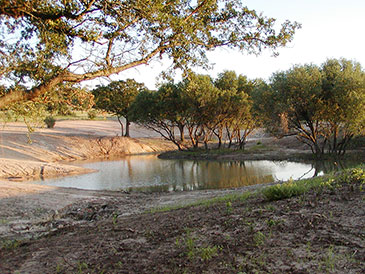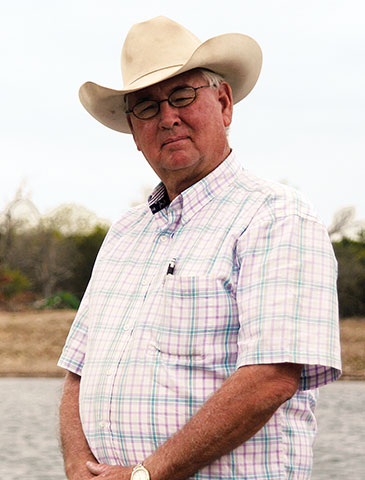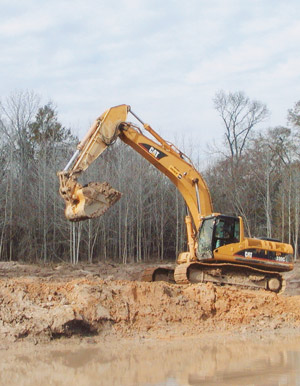Call it a stock tank, a pond, a lake or a favorite fishing hole. Whatever the name, a body of water can add significant beauty and value to rural property. To keep that picturesque pond from becoming a landowner liability, however, do your research and proper planning before you begin construction.

Ponds enhance the attractiveness and functionality of the land, which in turn increase its value and desirability. Pond construction is one of many types of rural property improvements eligible for Farm Credit financing.
Photo courtesy of Farm and Ranch Construction
Ponds enhance the attractiveness and functionality of the land, which in turn increase its value and desirability. Pond construction is one of many types of rural property improvements eligible for Farm Credit financing.
Texas Land Bank customer Ken Craig has been constructing ponds most of his life, and has owned and operated Farm and Ranch Construction in Cranfills Gap, Texas, since 1987. As a specialist in farm and ranch construction, Craig knows which factors to consider when adding a pond and how to make it the best possible investment for rural land.
Location, Location, Location
When determining where to build a pond, Craig says that the three most important factors are: topography, the purpose of the pond, and geology.
Topography
The topography of the land is especially important and the first factor that must be considered. A certain amount of watershed — typically 75 acres for every 1 acre of surface water — must be available.
"It’s easy to overbuild if you don’t understand the watershed," he says. "However, the watershed doesn’t have to be on your property. It can include other people’s property, but it must be the right size to successfully handle the surface runoff and allow the pond to maintain a proper water level."
Purpose
The size, slope and depth of a pond should vary depending on whether it is used as a water source for livestock or as a recreational lake or fishing pond.
"For example, if you wanted to build a fishing pond, you would want 70 percent of the shoreline to be relatively steep," Craig says. "This discourages moss and aquatic growth in the top three feet of the pond, where your smaller fish could hide from the game fish you’re trying to catch."

Ken Craig
Photo by Sarah Harris
Not only do types of ponds differ in design, but there are different legalities involved with each one, as well.
"If you are building a pond for livestock in Texas, you are legally able to build a pond that would impound 200 acre-feet (65,170,200 gallons) of water, and the water from the spillway must be returned to original drainage before exiting the property," Craig says.
Geology
The geology of the land must also be taken into account. The ideal soil type is one that contains a good-quality clay material to keep the pond from leaking. However, a lake or pond can be built on soil types that are prone to leaking, says Craig, if one of three following preventatives is used: soil-bentonite cutoff walls, bentonite liners or PVC liners. Although these options are expensive, they help keep seepage to a minimum, he explains.
Keeping It Full
After selecting the best location, determine the depth of the pond. Evaporation needs to be considered, because in a hot climate losses can be significant. In an extreme summer, a pond can lose up to 1 inch of water a day from surface-water evaporation. Over a 60- to 90-day season, that can total 5 to 9 feet of evaporation loss.
In some instances, depending on the watershed and geology involved, Craig recommends digging a "pit" from an existing water source, such as a creek or spring. He likes this method because a pond formed from the pit will maintain the same water level as the flowing creek or spring, and it is not at risk for leakage.
"Live water is one of the absolute best kinds of water resource you can spend money on," Craig attests.
The Right Equipment
Another key to successful construction is using the right equipment. While bulldozers and scrapers have been used for decades, Craig also uses an excavator to cut the bank at a 90° angle, creating a bluff and giving a fishing pond a perfect slope.
"I’ve found that an excavator does a better job at creating the vision that most people have of a fishing pond," he reports.

Craig believes that an excavator is the best piece of equipment for successful pond construction.
Photo courtesy of Farm and Ranch Construction
Craig says the most important piece of advice that he offers — even to people who don’t choose to do business with him — is to involve someone who’ll be honest about the size of pond the property is capable of handling. He says he has often seen people overbuild, only to have their pond result in a half-full mudhole that is unsightly and underutilized.
"A half-full resource is a liability to your property," he adds. "So many people don’t understand that there’s a lot more to it than just digging a hole."
Farm and Ranch Construction
Ken Craig’s family has worked in farm and ranch construction since 1949, and he and his wife, Amye, founded their own business, Farm and Ranch Construction, in 1987. In addition to constructing and repairing ponds and lakes across the entire state of Texas, Farm and Ranch Construction offers a variety of other services, including pre-purchase land consulting, brush clearing, rangeland grass planting and prescribed burning. Craig also builds country homes, ranch roads, entryways and fences.
A Texas Land Bank borrower since 2001, he has referred several of his customers to Lee Loeffler in the Land Bank’s Lampasas credit office.
"I’ve financed several properties that Ken has worked on and I know that he does an excellent job," Loeffler says. "We’ve worked well together in that he has referred his customers to me, and I’ve referred Texas Land Bank customers to him."
For more information on Farm and Ranch Construction, visit www.craigfarc.com.
-Sarah Harris